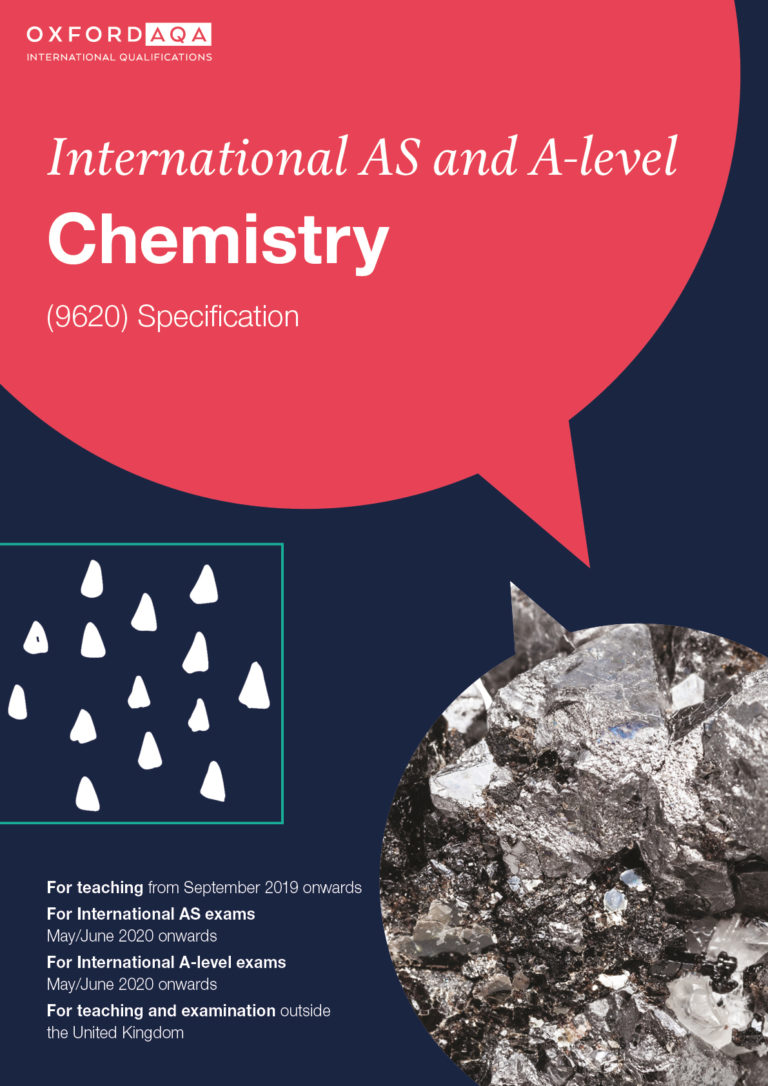
Give your students a broad range of experience in the three areas of physical, organic and inorganic chemistry.
Mirroring the way many universities split their content, each section begins with an overview, which puts the topic into a broader chemical context and ensures understanding of the place of each topic within the subject. These overviews encourage an overarching approach to the teaching and learning of topic areas. In addition, the latest version of this specification takes a more modular approach to physical chemistry, with units re-ordered to simplify teaching and revision.
- Practical work is at the heart of science. We recognise this, so our specification includes ten practicals that have been designed to give students a broad range of hands-on knowledge.
- These practical components are flexible around local access to equipment and materials, with practical knowledge assessed through the main exam papers.
- Our papers are carefully designed to avoid cultural or linguistic bias, using the principles of Fair Assessment and the Oxford 3000 to ensure the vocabulary is as clear as possible.
- Exam papers include a range of question styles allowing students to demonstrate scientific skills, logical thinking and depth of knowledge.
International AS and A-level Chemistry (9620)
Unit 1: Inorganic 1 and Physical 1 (AS)
Unit 2: Organic 1 and Physical 1 (AS)
Unit 3: Inorganic 2 and Physical 2 (A2)
Unit 4: Organic 2 and Physical 2 (A2)
Unit 5: Practical and synoptic (A2)
View the switching guide to see the differences between your old International AS/A-level Chemistry specification and the OxfordAQA specification (version updated November 2022).
OxfordAQA International AS/A-level Chemistry covers the following topics:
Physical chemistry
- Atomic structure
- Amount of substance
- Bonding
- Energetics
- Oxidation, reduction and redox equations
- Kinetics
- Chemical equilibria, Le Chatelier’s principle and Kc
- Thermodynamics (A-level only)
- Electrode potentials and electrochemical cells (A-level only)
- Acids and bases (A-level only)
- Rate equations (A-level only)
- Equilibrium constant Kp for homogeneous systems (A-level only)
Inorganic chemistry
- Periodicity
- Group 2, the alkaline earth metals
- Group 7(17), the halogens
- Properties of Period 3 elements and their oxides
- Transition metals (A-level only)
- Reactions of ions in aqueous solution (A-level only)
Organic chemistry
- Introduction to organic chemistry
- Alkanes
- Halogenoalkanes
- Alkenes
- Alcohols
- Organic analysis
- Optical isomerism (A-level only)
- Aldehydes and ketones (A-level only)
- Carboxylic acids and derivatives (A-level only)
- Aromatic chemistry (A-level only)
- Amines (A-level only)
- Polymers (A-level only)
- Amino acids and proteins (A-level only)
- Organic synthesis (A-level only)
- Nuclear magnetic resonance spectroscopy (A-level only)
- Chromatography (A-level only)
OxfordAQA provides all the resources and advice you need to teach the International AS and A-level Chemistry specification effectively.
- Download the specification
- Read our switching guide
- View our training courses to help you deliver OxfordAQA International AS and A-level Chemistry
- Approved textbooks and resources published by Oxford University Press
We have too many International AS and A-level Chemistry resources to list here, so please visit our resource area for teachers to see them all, including:
- Schemes of work to allow you to plan how to deliver the specification in a way that will best suit you and your students
- Teaching guidance to outline clearly the scope of teaching and learning
- Topic tests and mock exam analysers to allow you to track your students’ progress throughout the teaching year
This is a modular qualification, with five papers over the AS and A-level teaching period.
AS Paper 1 – Inorganic 1 and Physical 1:
- Any part of 3.1.1 – 3.1.5 of the Physical Chemistry section of the specification may be assessed
- Any part of 3.2.1 – 3.2.3 of the Inorganic Chemistry section of the specification may be assessed
- 1 hour 30 minutes
- 70 marks
- 50% of AS-level, 20% of A-level
AS Paper 2 – Organic 1 and Physical 1:
- Any part of 3.1.6 – 3.1.7 of the Physical Chemistry section of the specification may be assessed
- Any part of 3.3.1 – 3.3.6 of the Organic Chemistry section of the specification may be assessed
- 1 hour 30 minutes
- 70 marks
- 50% of AS-level, 20% of A-level
A-level Paper 1 – Inorganic 2 and Physical 2:
- Any part of 3.1.8 – 3.1.10 of the Physical Chemistry section of the specification may be assessed
- Any part of 3.2.4 – 3.2.6 of the Inorganic Chemistry section of the specification may be assessed
- 1 hour 30 minutes
- 80 marks
- 21% of A-level
A-level Paper 2 – Organic 2 and Physical 2:
- Any part of 3.1.11 – 3.1.12 of the Physical Chemistry section of the specification may be assessed
- Any part of 3.3.7 – 3.3.16 of the Organic Chemistry section of the specification may be assessed
- 1 hour 30 minutes
- 80 marks
- 21% of A-level
A-level Paper 3 – Practical and Synoptic Paper:
- Any part of the specification may be assessed
- 1 hour 25 minutes
- 60 marks
- 18% of A-level
Re-sits
- Candidates may re-sit a unit any number of times.
- The best result for each unit will count towards the final qualification.
- Candidates who wish to repeat a qualification may do so by re-sitting one or more units.
Take a look at:
- The OxfordAQA International AS and A-level Chemistry switching guide
- Example specimen exam paper and mark scheme
You must be an approved OxfordAQA centre to enter students for our exams. Make sure you become an OxfordAQA centre before you start teaching a course.




